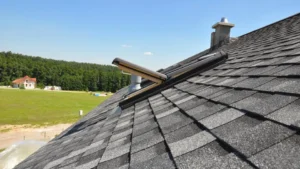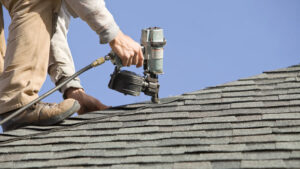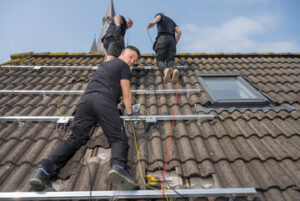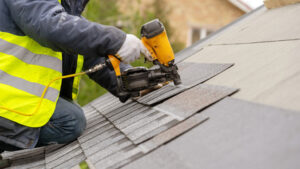Roofing Round Rock is a covering that protects a building or structure against rain, snow, sunlight, and extremes of temperature. It can be constructed from a wide range of materials.
Some roofing systems require specialized knowledge to maintain or repair. For example, slate requires a highly skilled tradesperson to install hand-rived or milled slate shingles.

Often seen in Southwest-style and Mediterranean-inspired homes, tile roofs give off an exotic sense of romance. There’s much more to this type of roofing than meets the eye, though; these roofs provide excellent durability and are even more effective at keeping your home cool than other types of roofs, such as asphalt shingles.
Originally made from local, natural materials like terra-cotta, clay, and slate, these overlapping tiles are renowned for their lifelong durability and fireproofing properties. Modern roofing tiles are crafted from concrete, metal, and other materials and offer the same superior qualities.
Tiles also offer more color versatility than other roof materials. While shingles can only be purchased in a limited range of colors and styles, many manufacturers of clay or concrete roof tiles produce them in various shades, tones, and textures.
These roofs are also more resistant to heat, which means they keep the interior of your home cooler and reduce heating costs. Unlike wood or shake roofs, tile allows hot air to circulate, so it doesn’t trap heat. In addition, these types of roofs are also fireproof, making them safer for your home’s inhabitants during a wildfire.
Aside from their impressive lifespans, these roofs are easy to maintain and repair. Since the tiles are not attached to the underside of your roof, they can be removed and replaced if damaged or worn. The bottom of a tile roof is also easy to access, making it simpler to take care of any issues with the gutter system and downspouts.
Compared to other types of roofing, tile roofs tend to be more expensive upfront for materials and installation, but they have a lower maintenance cost over the roof’s lifespan. They can withstand high winds, hail, and freeze/thaw climates better than other roof types. Clay and slate roofs, for example, can last up to 100 years, while some concrete tiles have a lifetime warranty. Moreover, tile roofs are more effective than other roofs at shielding your home from extreme weather conditions, which is ideal for unpredictable climates.
Metal roofs are becoming more popular with homeowners as they learn of the longevity and cost savings associated with them. The price of a new metal roof can be more than double that of an asphalt shingle roof, but over the lifespan of the metal roof, it can pay for itself. A properly installed and maintained metal roof can last 50 years or more, requiring little maintenance.
Several types of metal roofing include corrugated panels, standing seams, and metal shingles. The most important consideration when choosing a metal roof is that the metal used for your roof has been treated to prevent rust and corrosion in the climate where you live. In addition, there are several options for warranties to protect your investment in a metal roof, including weathertight and paint warranties.
The longevity of a metal roof can be greatly enhanced by using a cool chemistry paint system with solar reflectance and thermal emittance properties. These cool chemistry coatings allow a metal roof to shed absorbed heat at night, which helps cut energy costs and promote environmental sustainability. Metal roofing with these new cool chemistry paint systems can qualify a roof for Energy Star ratings and contribute to LEED points on green building projects.
Whether you are looking for a traditional look or a modern style, there is a metal roofing option that will fit your home and budget. When purchasing a metal roof, it is very important to find a manufacturer that sells directly to the homeowner or roofing contractor so that you can compare bids for the entire roof, not just labor.
All metal roofing starts as metal coils, which are then rolled into sheets or panels for installation. These panels are then shaped into the desired profile/ribbing structure, and the sheet metal is fastened to the roof sheathing and trim with clips that mount to the ridge and valley areas. Many panels are finished with an attractive paint system to enhance your home’s curb appeal.
Asphalt shingles are a common choice for roofs because they offer many styles to complement different types of homes. You can choose from traditional three-tab shingles that work well with various home styles and premium or dimensional asphalt shingles that are available in multiple styles. Some even mimic the appearance of slate or cedar shakes.
With the many choices in shapes, colors, and textures for asphalt shingles, you can create a unique look for your home. The appearance of a roof can also be accentuated with the use of ridge caps and hip caps. Specialty shingle shapes such as art-loc, tie lock, and t-lock can also be used to give a dimensional look.
In terms of durability and lifespan, a high-quality asphalt composite shingle will have a life expectancy of about 30 years. These shingles are also easy to install, which can help reduce labor costs compared to other roofing materials like metal.
Another great benefit of a new asphalt roof is its ability to dampen sound, which can help to create a quieter environment inside the building. This can promote more productive workspaces inside the building. However, unlike other roofing options, a new asphalt composite shingle will be less energy efficient.
While asphalt shingles are less expensive than other roofing materials, they can still be costly. As a result, you should research your options and find the best quality shingles that fit your budget. Always consider a roofing material’s longevity before making a final decision.
When choosing a roofing contractor, you should also ensure they have the experience and knowledge to provide you with the highest-quality service possible. A good way to do this is to check the company’s accreditation and certifications. Specifically, you should choose a roofing contractor certified by the National Roofing Contractors Association (NRCA).
In addition to providing a high-quality roof, an experienced and trusted roofing contractor can provide you with a wide range of services, such as ice and water barriers, flashing, and leak detection. In addition, a good roofing contractor can offer you a warranty on their work.
Wood shingles and shakes provide a natural look with a rustic appeal. The sturdiness of a wood roof can withstand high winds without damaging the house or its structural elements. They also provide a good level of insulation, which can help lower energy bills, as well as offer protection against UV rays.
When it comes to a wooden roof, the wood used can impact the cost. Cedar and redwood are typically the most popular types of wood for roofing, but there are other options as well. Some types of wood tend to absorb moisture and swell, which can lead to warping and further damage over time. Wood shingles and shakes can be treated with stain or paint to prevent this from happening, but this doesn’t necessarily make them impervious to water.
The main drawback of a wood roof is its higher maintenance requirements than other roofing materials. It will need to be treated with fire retardant chemicals every two to five years, and it is more likely to experience problems such as mold, mildew, and fungus. It can also rot and split over time, leading to expensive repairs. In addition, it is susceptible to insect infestations like termites and other wood-boring insects.
A wood roof is a good choice for homeowners who want to save money on electricity bills, as it has natural insulating properties and can be topped with additional insulating material to improve its performance even more. However, a wood roof isn’t recommended for homes in areas that are regularly subject to wildfires or other types of catastrophic weather events.
When choosing a wood roof, it is important to consider the cost and benefits and the climate where you live. For example, a pine wood roof will be cheaper to install but may require regular maintenance and replacement as it is more prone to rot than other wooden roofs. It’s best to consult a professional roofer to determine what type of wooden roof is right for you. Then, you can choose a color and style that matches your home and suits your budget.





